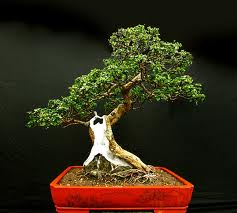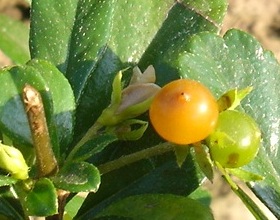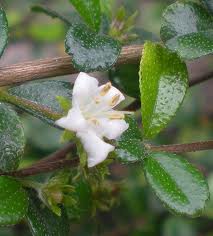Fukien Tea Bonsai Tree
Fukien tea bonsai tree is a perfect choice for a bonsai artist.
It is a fast growing hardy tree, but can be pretty difficult to look after, particularly for bonsai beginners. Fukien tea is very popular for bonsai in China, but not a traditional favorite in Japan.
This tropical evergreen genus is named after the Fukien or Fujien province of Southeastern China, from which the plant originates and can grow as a small tree or shrub to twelve feet in height. It is most often listed by its old scientific name of Carmona microphylla but its most recent scientific name is Ehretia micropylla (buxifolia).
When considering its common name, I keep wondering whether Fukien tea leaves can actually be used for making tea. I tried to search but haven’t found any appropriate answer yet. Though its name has the word “tea” indicating a drinkable beverage, I still doubt about a possibility of toxic substance in its leaves. Hope that one day some Chinese bonsai hobbyists can have a proper clarification about the matter.

Favorable Bonsai Characteristics
Among popular types of bonsai trees, Fukien tea has a few of very favorable characteristics to become a good bonsai.
Grey bark – The bark of a Fukien tea bonsai tree starts out with attractive light brown color. As the tree grows older, the bark turns dark brown with darker, warty elevated areas, which forms a cracked, fissured appearance with age.
Small leaves - Its small glossy leaves allow it to be used for even the little bonsai. The shiny, oval, dark-green leaves are covered in with small hairs and keep their luster all year round. Each tiny leaf maintains its adorable size as the tree grows and is sculpted into a bonsai. Though small, the leaves of a Fukien tea bonsai tree make thick, dense foliage in their prime.
Twiggy branches – with your dedicated trimming effort, your plant will have twiggy branches thus producing a more refined bonsai.

Dainty flowers- clusters of small white five-petal flowers, from early spring through late fall.
Prolific fruits – Fukien tea is prolific with tiny yellow to red, two-seeded berries. As the blooms age, they turn into tiny round fruits. The fruits of a Fukien tea tree, usually appearing in early summer, can be green, yellow or red.
Cultivation Tips
Though easily available at bonsai outlets, the Fukien Tea can be difficult to look after, particularly for beginners.
Water – The best practice for watering a Fukien tea bonsai tree is to give it a good watering and then wait for several days until the soil is getting dry before adding more liquid. Over-watering also results in yellow, sickly leaves. Under-watering a Fukien tea bonsai can result in the leaves looking shriveled. This can usually be reversed, if caught early, by watering the plant immediately. If water doesn’t arrive in time, the dried out leaves will turn black and drop off the plant.
Fertilizer - Fertilize the tree every one-two weeks during growth, and every four-six weeks in winter. Always water well before fertilizing and mix the fertilizer at half the recommended dilution. Fertilize the tree as long as it is growing. Do not fertilize a newly purchased, transplanted or sick tree.
Soil - Fukien tea bonsai trees are not picky about the quality or make-up of soil that they are planted in. But it is essential that drainage is maintained at all times. The most common problem with Fukien bonsai is rotting roots from compacted, soggy soil. The Fukien tea tree prefers soil that ranges from moist to slightly dry.
Temperature – The tree is quite sensitive to sudden changes in temperature and lighting. Temperatures for the Fukien tea should be maintained between 59-77°F degrees (15-25°C) in the summer.
Humidity – Humidity is an important concern when it comes to growing a healthy and attractive Fukien bonsai. When growing the tree indoors, you can purchase a humidity tray to capture water when watering and keeping moisture around the tree. In general, a Fukien bonsai refers humidity levels over 20%.
Light - Likes a bright position (1000 Lux). Most sources recommend only about an hour of direct sunlight daily, although success has been reported growing it in a sunny position all day. If you nurture the tree indoors, it lives happily in a bright window with south or west exposure. If the window has north or east exposure give the tree supplementary light with a fluorescent bulb 4-6 in inches from the tree’s top for 10-12 hours each day.
Pests and diseases – Fukien tea is susceptible to scale, mealy-bugs, snails, and aphids. Unfortunately, Fukien tea is very sensitive to insecticides, and Diazinon will kill the tree. Use the weakest insecticide possible or use organic insecticidal soap, or if possible, employ predator insects to deal with pest and disease problems.
Location - It can be grown outdoors in warm climates, but is quite popular as an indoor bonsai.
Training

Wiring – Though not necessary, you can wire the new growth on a Fukien Tea bonsai tree. Be careful, the wire may start to cut into the tree after about three months. That is undesirable as it may leave scars in the trunk. Use the proper size wire for the branch, and do NOT wire a bonsai just after repotting.
Pruning - Pruning the branches can be done at any time of the year. You should pinch out the new shoots when they appear in undesirable places. You can also use the clip-and-grow method to train your tree. (Read more about bonsai pruning)
Styling - Two of the most successful bonsai training styles for Fukien tea are formal and informal upright bonsai. Some imported old trees have enough curves in them to also be used as cascades, slant or even literati styles.
Choosing pots - A very dark blue glazed bonsai container may work. However, a brown unglazed pot can emphasize a rugged trunk.
Re-potting – you should report Fukien Tea bonsai tree every 2 to 3 years. You should also trim the roots back. Your Fujian Tea should be potted in a quick draining premium potting mix, or you can invest in a good bonsai soil, the choice is up to your personal preference. Make sure your pot drains well.
Propagation
You can try to propagate Fukien tea bonsai trees by seed, air layering, or softwood cuttings in spring or summer.
Propagating from fresh seed is very easy. Remove the moist coating from the fruit, plant the fresh seed in bonsai soil, and keep it moist. In one to 4 weeks, small seedlings will poke up out of the soil. Allow them to grow for a year and once they are slightly woody use wire to give the trunks movement.
Stem cuttings root very easily. Use any cutting with a green or softwood stem and cuttings from vigorous plants increases the success rate.



New! Comments
Have your say about what you just read! Leave me a comment in the box below.